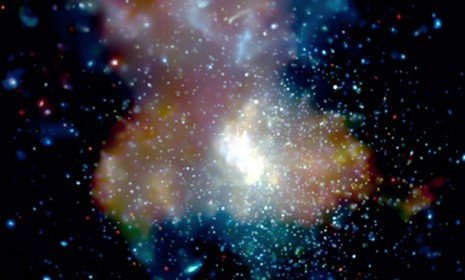Is the Milky Way a galaxy killer?
Scientists once theorized that we have 500 galactic neighbors — but it turns out that, once the Milky Way wreaked its havoc, only 20 survived

Why doesn't our Milky Way galaxy have many neighbors? Because it throttled nearby star systems during the universe's youth, according to a new study presented by French researchers Pierre Ocvirk and Dominique Aubert. Published in the Monthly Notices of the Royal Astronomical Society, the study examines why few galaxies exist in close proximity to the Milky Way, while galaxies farther away have thrived. It turns out the Milky Way is not easy to live next to. Here, a guide to their findings:
Could I get a quick refresher course on the Milky Way?
Of course: It's the galaxy where Earth and its solar system lives. Our sun is just one of hundreds of billions of stars in the Milky Way galaxy — which is roughly 100,000 light years in diameter.
The Week
Escape your echo chamber. Get the facts behind the news, plus analysis from multiple perspectives.

Sign up for The Week's Free Newsletters
From our morning news briefing to a weekly Good News Newsletter, get the best of The Week delivered directly to your inbox.
From our morning news briefing to a weekly Good News Newsletter, get the best of The Week delivered directly to your inbox.
And our galaxy doesn't have neighbors?
Not nearly as many as once believed. Typically, large galaxies like the Milky Way have "satellite galaxies" encircling them. Once, scientists posited "as many as 500" such satellite galaxies around the Milky Way, says Tammy Plotner at Universe Today. But only 10 have been found, and scientists now believe there are likely only 20 within 900,000 light years of the Milky Way. "So what happened to the other 480 that should be out there?" It's something scientists term the "missing satellites" problem.
What happened?
At first, scientists thought a 12-billion-year-old process called reionization was to blame. That occurs when ultraviolet (UV) light from mature stars, such as the Milky Way's, cut up the hydrogen atoms that new stars need to form, says Science Daily. But the new findings throw another variable into the mix: Invisible "dark matter." That mysterious dark matter, which makes up 23 percent of the universe, neither emits nor scatters light, so it can't be seen. Its existence is inferred from the gravitational effects we see on other objects in space. And it turns out, researchers say, that dark matter caused the Milky Way's UV rays to be most intense near the center of our galaxy, and weaken the farther away the UV rays got. This explains why satellite galaxies "close to the galactic center [saw] their gas evaporate very quickly," says Ocvirk, while remote formations were able to "keep their gas longer, and form more stars."
A free daily email with the biggest news stories of the day – and the best features from TheWeek.com
So the Milky Way "killed" other galaxies?
Basically. Stars began forming 150 million years or so after the Big Bang. But in our stellar neighborhood, the Milky Way's UV light killed many stars that could have grown into satellite galaxies, throttling them before they could even form.
Sources: Cordis, Science Daily, Universe Today
-
 US citizens are carrying passports amid ICE fears
US citizens are carrying passports amid ICE fearsThe Explainer ‘You do what you have to do to avoid problems,’ one person told The Guardian
-
 All roads to Ukraine-Russia peace run through Donetsk
All roads to Ukraine-Russia peace run through DonetskIN THE SPOTLIGHT Volodymyr Zelenskyy is floating a major concession on one of the thorniest issues in the complex negotiations between Ukraine and Russia
-
 Why is Trump killing off clean energy?
Why is Trump killing off clean energy?Today's Big Question The president halts offshore wind farm construction